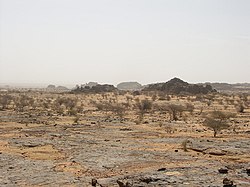Aoukar
Aoukar
عوكر | |
|---|---|
 Landscape in the Ayoun el Atrous area | |
 Location of the Aoukar basin in Mauritania | |
| Country | Mauritania |
| Elevation | 240 m (790 ft) |
Aoukar or Erg Aoukar
The Aoukar basin is a dry
sand dunes and salt pans fringed by escarpments
on its northern and eastern sides.
History
There was once vast reed-covered endorheic lake in the area, but it no longer exists. The former lake of Aoukar extended towards the area of Tichit, bordering the southern edge of the Tagant Plateau. Below the cliffs (dhars) facing the extinct lake remains of about 400 villages have been found.[6][7]
Umar Tall
.From east to west, Dhar
Previously administered as part of
French Mauritania in 1944, apparently on a whim of the colonial governor Laigret.[13] The transfer was still resented upon Mali's independence.[14] Formerly more fertile, it is now largely a barren waste.[15]
Aoukar/Hodh gave its name to the modern Mauritanian regions of Hodh Ech Chargui and Hodh El Gharbi.
Ecology
The Aoukar is one of the few natural refuges for the
critically endangered kind of antelope which lives in the region.[16]
See also
References
- ^ Marco Stoppato, Alfredo Bini (2003), Deserts, p. 156
- ^ Fāsī, Muḥammad & al. General History of Africa, Vol. III: Africa from the Seventh to the Eleventh Century, p. 130. UNESCO (Paris), 1988. Accessed 18 Apr 2014.
- ^ Harper & Bros. (New York), 1859. Accessed 18 Apr 2014.
- ^ Ould-Mey, Mohameden. Global Restructuring and Peripheral States: The Carrot and the Stick in Mauritania, p. 66. Rowman & Littlefield (Lanham), 1996. Accessed 18 Apr 2014.
- ^ Also encountered as Hōdh, Ḥawḍ,[2] Hódh,[3] and al-Hodh.[4]
- ^ "Tichit - The living ghost of yesterday's glory". Archived from the original on 2016-03-04. Retrieved 2014-08-13.
- ^ G. Marcus and B. de Valicourt (2000). Mauritanie, p. 10
- ^ a b MacDonald, Kevin C.; Vernet, Robert; Martinon-Torres, Marcos; Fuller, Dorian Q. "Dhar Néma: From early agriculture to metallurgy in southeastern Mauritania". ResearchGate. Azania Archaeological Research in Africa.
- ISBN 978-0-19-027773-4.
- ^ Holl, Augustin F.C. "Coping with uncertainty: Neolithic life in the Dhar Tichitt-Walata, Mauritania, (ca. 4000–2300 BP)". ScienceDirect. Comptes Rendus Geoscience.
- ISBN 9789077922309.
- S2CID 134223231.
- ^ Lalonde, Suzanne. Determining Boundaries in a Conflicted World: The Role of Uti Possidetis, p. 109. McGill-Queen's University Press (Montreal), 2002. Accessed 18 Apr 2014.
- ISBN 1583484221. Accessed 18 Apr 2014.
- ^ Morgan, William & al. West Africa, pp. 254 ff. Methuen, 1973.
- ^ Richard Trillo, The Rough Guide to West Africa
